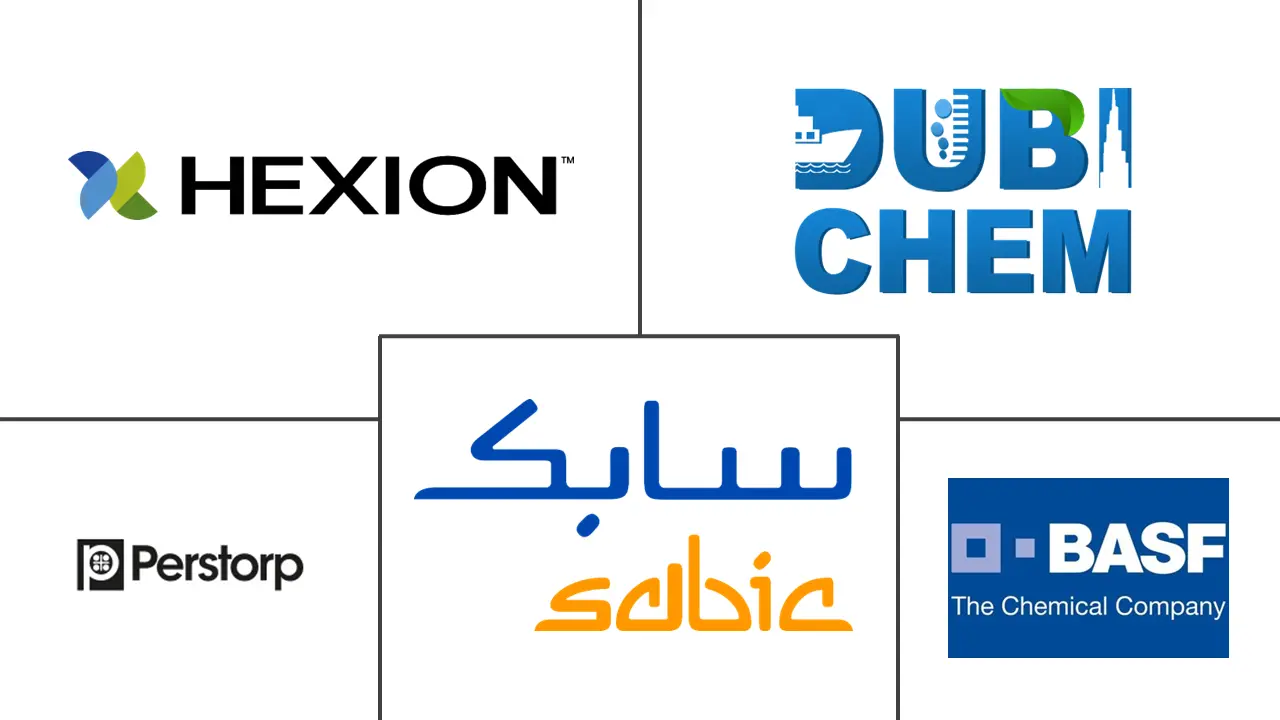Middle East Formaldehyde Market Size and Share
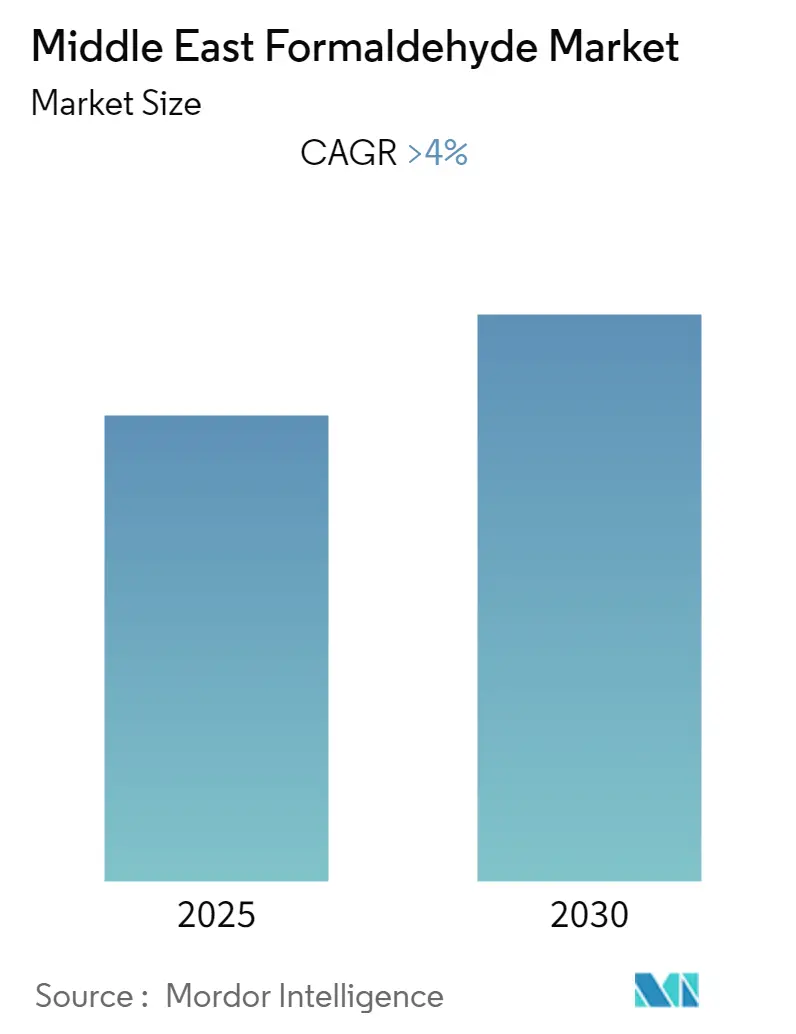
Middle East Formaldehyde Market Analysis by Mordor Intelligence
The Middle East Formaldehyde Market is expected to register a CAGR of greater than 4% during the forecast period.
During the COVID-19 pandemic, there was a negative impact on the formaldehyde market in the Middle East region due to disruptions in construction activities and supply chains, production halts, and labor shortages. However, the healthcare segment was improving in the industry, which was expected to aid market growth. The Middle East Formaldehyde Market recovered from the pandemic and was growing significantly.
Over the short term, due to formaldehyde's diverse and advantageous chemical features, its employment in the automotive and construction industries is expanding exponentially. It is projected to fuel market growth throughout the forecast period.
However, the hazardous and carcinogenic nature of formaldehyde and the stringent limits imposed by various authorities on formaldehyde emissions will likely hamper the growth of the Middle East formaldehyde market size.
Nevertheless, research and technological development (RTD) related to applying formaldehyde derivatives to treat Organic Fraction of Municipal Solid Waste (OFMSW) will likely create lucrative delivery opportunities for the Middle East formaldehyde market over the forecast period.
Middle East Formaldehyde Market Trends and Insights
Construction Industry to Dominate the Market
- The construction industry dominates due to large-scale formaldehyde usage for building, renovation, and furniture making.
- Formaldehyde-based resins are necessary for manufacturing composite and engineered wood products, which are widely used in cabinetry, countertops, moldings, furniture, shelves, stair systems, flooring, wall sheathing, support beams, and trusses, and many other home furnishings and structures.
- Many panels and board products in the wood products sector use formaldehyde-based resins, enabling the sustainable use of forestry resources and the reduction of waste. Composite wood panels are commonly created from recovered wood waste, which would otherwise be burnt or disposed of in a landfill.
- Solid timber can only use 63% of the tree, but composite panels can use more than 95%. In addition to increasing the usage of wood, formaldehyde-based chemistry helps to create stronger, more lasting final construction materials. Formaldehyde-based glues are excellent bonding agents that produce high-quality, low-cost outcomes.
- The Middle Eastern construction industry is expanding. The Saudi government focuses on boosting the education, healthcare, infrastructure, and industrial sectors for economic diversification. As a result, demand for institutional, residential, industrial, and commercial buildings is likely to rise.
- From 2010 to 2025, Saudi Arabia's first-phase projects have a combined budget of USD 16.8 billion, including the construction and upgrade of 5500 kilometers of track. The Saudi Railway Master Plan's (SRMP) second-phase projects will build 3000 km of track for USD 55.7 billion, while the third-phase plans will build 1400 km for USD 24.8 billion between 2034 and 2040. It was also intended to gradually privatize services while independently maintaining the regulatory and operational sectors of the railway firm.
- Qatar is pursuing a wide range of infrastructural and industrial projects as part of its commitment to hosting the 2022 FIFA World Cup, its commitment to its National Vision 2030, and its objective of hosting the Asian Games in 2030. In the run-up to the 2022 FIFA World Cup, a few high-value road and rail transportation projects will be built over the following two years to improve connectivity and alleviate the problem of excessive congestion around Doha.
- The UAE is also working toward a brighter and more environmentally friendly future. Masdar Metropolis is the first zo-carbon, zero-waste, car-free city in Abu Dhabi. The United Arab Emirates changed it from a future science notion to an organic, metropolitan organism. When completed in 2025, Masdar City will serve as a model for the rest of the region. The UAE construction industry is ready to enter a new period of growth, spurred by the country's lofty aspirations for the next 50 years and newer, more progressive legislation.
- According to the Federal Competitiveness and Statistics Authority (FCSA), the value of construction output in the United Arab Emirates in 2021 is AED 9.45 billion (USD 2.57 billion). Several initiatives and programs, including the Energy Strategy 2050, the Sheikh Zayed Housing Program, and the Dubai Tourism Strategy, are in the works to encourage the building industry.
- The operational budget of Kuwait's Ministry of Health is estimated to reach over USD 18 billion by 2030. There are also efforts to strengthen the country's ability to generate electricity. Increased demand for public housing is expected to drive long-term residential development growth, with the Public Authority for Housing and Welfare announcing plans to build 250,000 housing units over the next 15 years.
- Several significant commercial development projects in the Middle East are being pushed by government schemes such as Saudi Arabia Vision 2030, Abu Dhabi Economic Vision 2030, and others. Qiddiya, Sharaan Resort at Al-Ula, Al Widyan, King Fahad Medical City Expansion, and King Abdullah Bin Abdulaziz Medical Complexes are examples of Saudi Arabian building projects with a positive influence on market growth.
- Saudi Arabia spends most of its GDP on healthcare compared to other countries. However, the government's healthcare budget has decreased since 2021. Saudi Arabia has one of the highest medical professional concentrations per thousand population in the Middle East.
- All the factors above are expected to drive the construction industry, enhancing the demand for formaldehyde during the forecast period.
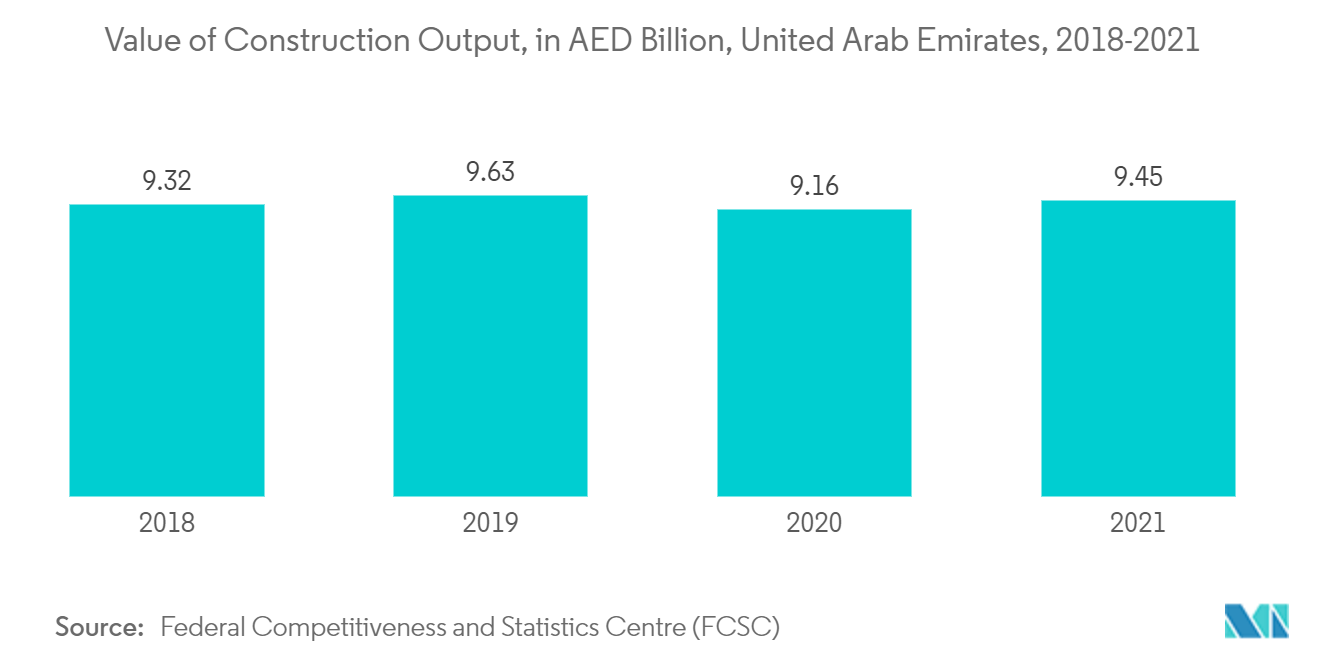
Saudi Arabia is Anticipated to Hold a Major Share of the Middle East
- Saudi Arabia holds a prominent share of the Middle East formaldehyde market in terms of market share and market revenue. The region will continue to flourish in its dominance over the forecast period.
- According to General Authority for Statistics (Saudi Arabia), the revenue from building construction in Saudi Arabia is expected to be roughly USD 28,7 billion by 2024.
- The construction industry accounts for roughly 6%-7% of the country's GDP. The Saudi government focuses on boosting the education, healthcare, infrastructure, and industrial sectors for economic diversification. As a result, demand for institutional, residential, industrial, and commercial buildings is likely to rise.
- According to the General Authority for Statistics (Saudi Arabia), The revenue of the industry "construction" in Saudi Arabia by segment was predicted to reach USD 55.19 billion in 2022, with a projection to 2024. Construction revenue in Saudi Arabia is expected to reach roughly USD 56.2 billion by 2024.
- The country is looking for qualified builders to shape its most ambitious projects, which have a USD 1.1 trillion project backlog. Saudi Arabia is amid Vision 2030, a major transformation agenda underpinned by megaprojects such as the Neom super-city tourist destination, the 334 km2 entertainment city of Qiddiya, the development at the UNESCO World Heritage site of Al-Ula, and the luxury and sustainable tourism-focused Red Sea Project.
- Furthermore, the Saudi Ministry of Housing intends to build around 100,000 additional housing units in collaboration with real estate companies for a total cost of SAR 65 billion. Nineteen projects have already been announced in nine country regions, with an additional 40 private projects expected to offer 14,000 "villa" housing units.
- Saudi Arabia is embarking on several residential and commercial projects, projected to boost the country's construction activity. The Neom Metropolis Project is a projected cross-border city in Tabuk Province, northwestern Saudi Arabia. Its goal is smart city technology while serving as a tourism destination. The region is located in the northern Red Sea, south of Jordan and Israel, and east of Egypt across the Tiran Strait.
- It will cover an estimated 26,500 km2 and stretch 460 kilometers along the Red Sea coast. Key components for the Neom project design were contributed by Singapore's Gardens by the Bay. The first phase of Saudi Arabia's Neom City Project will be finished by 2025. The scheme is expected to cost USD 500 billion.
- Thus, all the above factors will likely increase demand for the Asia-Pacific and Middle East formaldehyde market during the forecast period.
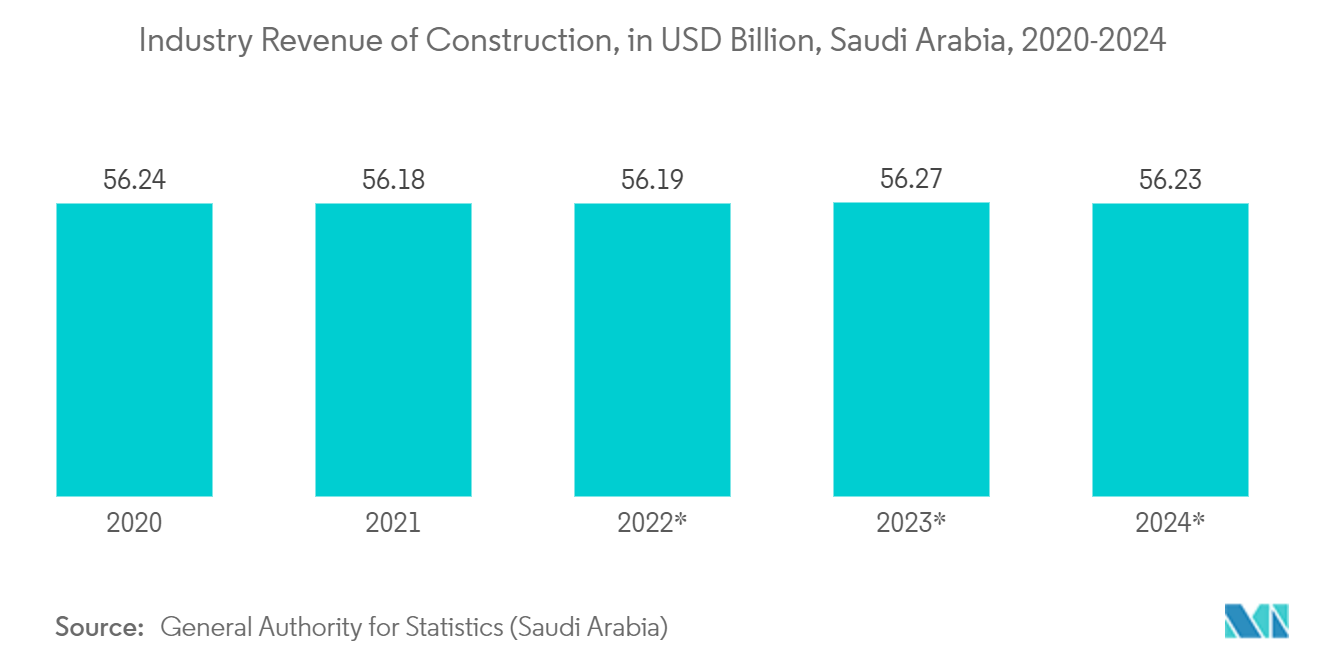
Competitive Landscape
The Asia-Pacific and Middle East Formaldehyde Market is fragmented, with a few large-sized players and many small players. Some of the major manufacturers in the market include BASF SE, Perstorp Orgnr, Hexion, Sabic, and Dubichem (in no particular order).
Middle East Formaldehyde Industry Leaders
-
BASF SE
-
Perstorp Orgnr
-
Hexion
-
Sabic
-
Dubichem
- *Disclaimer: Major Players sorted in no particular order
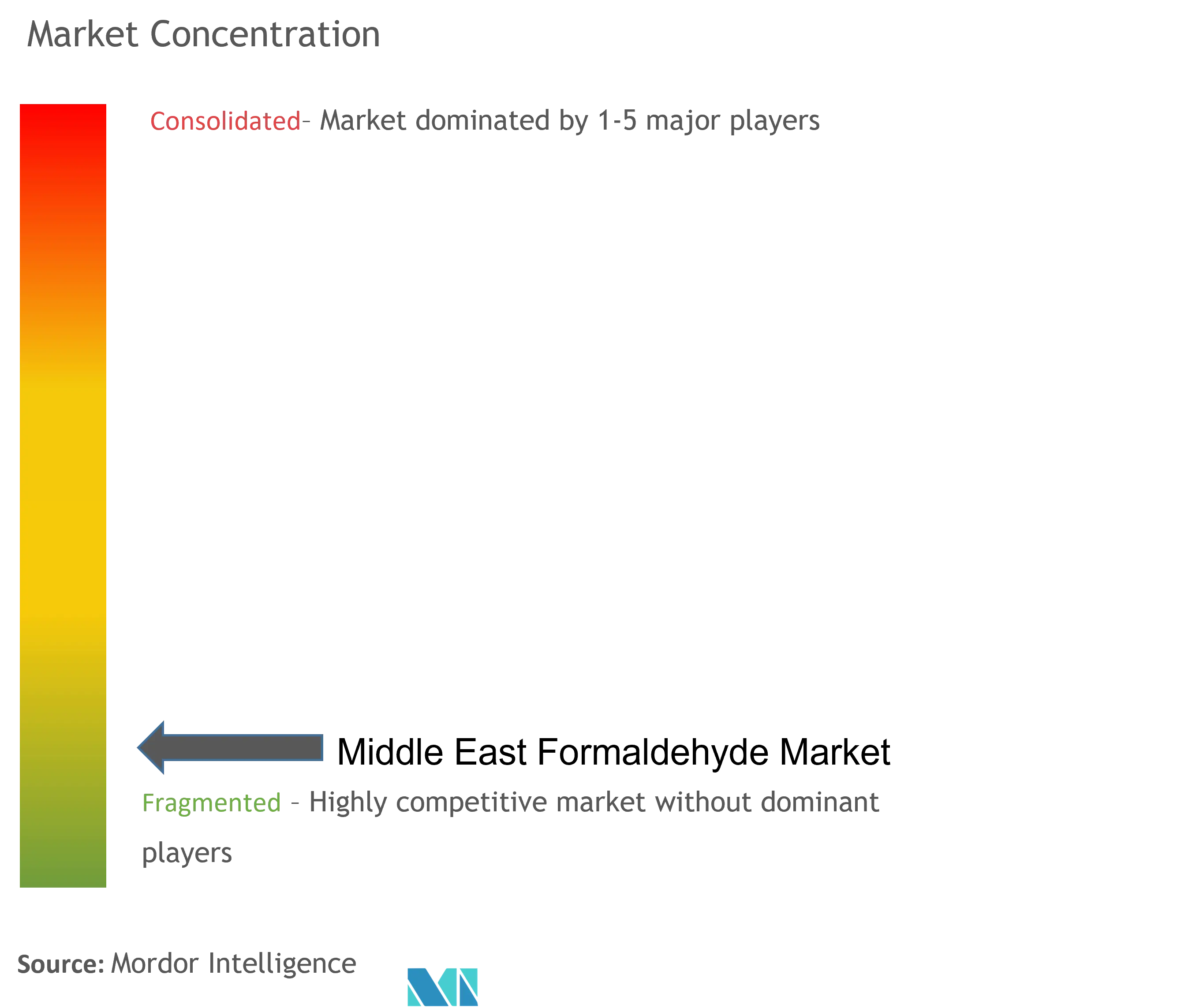
Recent Industry Developments
- November 2022: The Research and Development Council of New Jersey awarded a team of BASF researchers the prestigious 2022 Thomas Alva Edison Patent Award for the breakthrough FormaldpureTM Catalyst, designed to convert formaldehyde into carbon dioxide at room temperature, improving indoor air quality.
- January 2022: Methanol Chemicals Company (Chemanol) of Saudi Arabia granted the preliminary engineering design contract to expand its methanol facility. Chemanol, located in Al Jubail Industrial City, is one of the world's largest formaldehyde manufacturers, with a yearly production capacity of one million metric tons.
Middle East Formaldehyde Market Report Scope
Formaldehyde is a colorless hazardous gas formed by methanol oxidation employed as an antiseptic, disinfectant, histologic fixative, and general-purpose chemical reagent in laboratories. Formaldehyde (Methanal) is a naturally occurring chemical molecule with CH2O (HCHO) formula. It is a necessary precursor to various other minerals and chemical compounds. Formaldehyde is employed in various applications due to its diverse and advantageous chemical characteristics.
The Middle East Formaldehyde Market is segmented by derivatives (Urea Formaldehyde, Phenol-Formaldehyde, Melamine Formaldehyde, Hexamine, Polyoxymethylene, and Other Derivatives (Methylene Diphenyl Diisocyanate, Butanediol)), end-user industry (Automotive, Construction, Agriculture, Health Care, Chemical and Petrochemical, and other end-user Industries (Paints, Textiles)), and Geography (Saudi Arabia, Iran, United Arab Emirates, and Rest of Middle East). The report offers the market sizes and forecasts for the Middle East formaldehyde market in volume (kilotons) for all the above segments.
| Urea Formaldehyde |
| Phenol Formaldehyde |
| Melamine Formaldehyde |
| Hexamine |
| Polyoxymethylene |
| Other Derivatives (Methylene Diphenyl Diisocyanate, Butanediol) |
| Automotive |
| Construction |
| Agriculture |
| Health Care |
| Chemical and Petrochemical |
| Other End-user Industries (Paints, Textiles) |
| Saudi Arabia |
| Iran |
| United Arab Emirates |
| Rest of Middle East |
| Derivative | Urea Formaldehyde |
| Phenol Formaldehyde | |
| Melamine Formaldehyde | |
| Hexamine | |
| Polyoxymethylene | |
| Other Derivatives (Methylene Diphenyl Diisocyanate, Butanediol) | |
| End-user Industry | Automotive |
| Construction | |
| Agriculture | |
| Health Care | |
| Chemical and Petrochemical | |
| Other End-user Industries (Paints, Textiles) | |
| Geography | Saudi Arabia |
| Iran | |
| United Arab Emirates | |
| Rest of Middle East |
Key Questions Answered in the Report
What is the current undefined size?
The undefined is projected to register a CAGR of greater than 4% during the forecast period (2025-2030)
Who are the key players in undefined?
BASF SE, Perstorp Orgnr, Hexion, Sabic and Dubichem are the major companies operating in the undefined.
What years does this undefined cover?
The report covers the undefined historical market size for years: 2019, 2020, 2021, 2022, 2023 and 2024. The report also forecasts the undefined size for years: 2025, 2026, 2027, 2028, 2029 and 2030.
Page last updated on:
Middle East Formaldehyde Market Report
Statistics for the 2025 Middle East Formaldehyde market share, size and revenue growth rate, created by Mordor Intelligence™ Industry Reports. Middle East Formaldehyde analysis includes a market forecast outlook for 2025 to 2030 and historical overview. Get a sample of this industry analysis as a free report PDF download.
